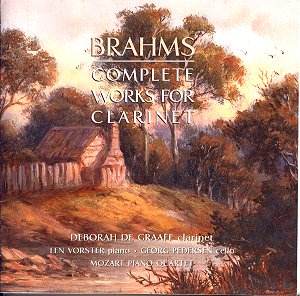Brahms wrote all these his works late in life. By 1891 the 58-year-old
composer had retired from composition, but his admiration for the playing
of his friend Richard Mühlfeld, a former violinist in the Meiningen
Orchestra, persuaded him to write what are now regarded as being among
his finest chamber compositions. The Quintet is a masterpiece
– a contemplative, autumnal work, in which the broad,
optimistic perspectives of the younger Brahms are replaced by a reflective
melancholy particularly suited to the clarinet. The Sonatas and Quintet,
have rarely been absent from major record catalogues, and today there
is a choice of outstanding performances to which, I am sorry to say,
this set cannot be added.
These are accomplished players, but a closed, unfocused recording does
them no favours, too closely recorded to blend well with either piano
or strings, and not surprisingly there is a certain amount of key-clatter.
In all of them the clarinet has an important share in the counterpoint
and the harmonic, as well as melodic, development of the music, and
in places tends to sound curiously detached from the ensemble. In parts
of the Sonatas de Graaff seems audibly stressed, when her playing comes
dangerously close to stridency and her intonation insecure, particularly
in the high register. In Sonata No.2 the choice of tempi is wayward,
as in the Sostenuto section of the second movement (marked Appassionato,
ma non troppo Allegro in my score and given as Allegretto appassionato
- Sostenuto in the insert booklet)where the haunting, song-like
tune marked piano ben cantando in my score is treated
as a plodding ¾ hymn with disastrous effect.
The players are more at home in the Trio, where the music unfolds naturally
and poignantly, with constantly shifting harmonies. The passages where
clarinet and cello interweave are highly effective. In the Quintet,
however, the self-assertive strings do not treat de Graaff kindly. The
delicate arabesques shared between them and the clarinet in the, Adagio
are handled almost casually, disturbing the unruffled surface of this
wonderful movement. Here also, as in the Sonatas, de Graaff’s tendency
to introduce a swelling of the tone in the high register is superfluous
to requirements. These comments are of course subjective, but for me
it all adds up to several performances short of an extra rehearsal or
two. As any student knows these works take a long time to reach a mature
interpretation: on these discs the potential is there, but too many
golden opportunities are missed for me to rate them highly.
Roy Brewer
